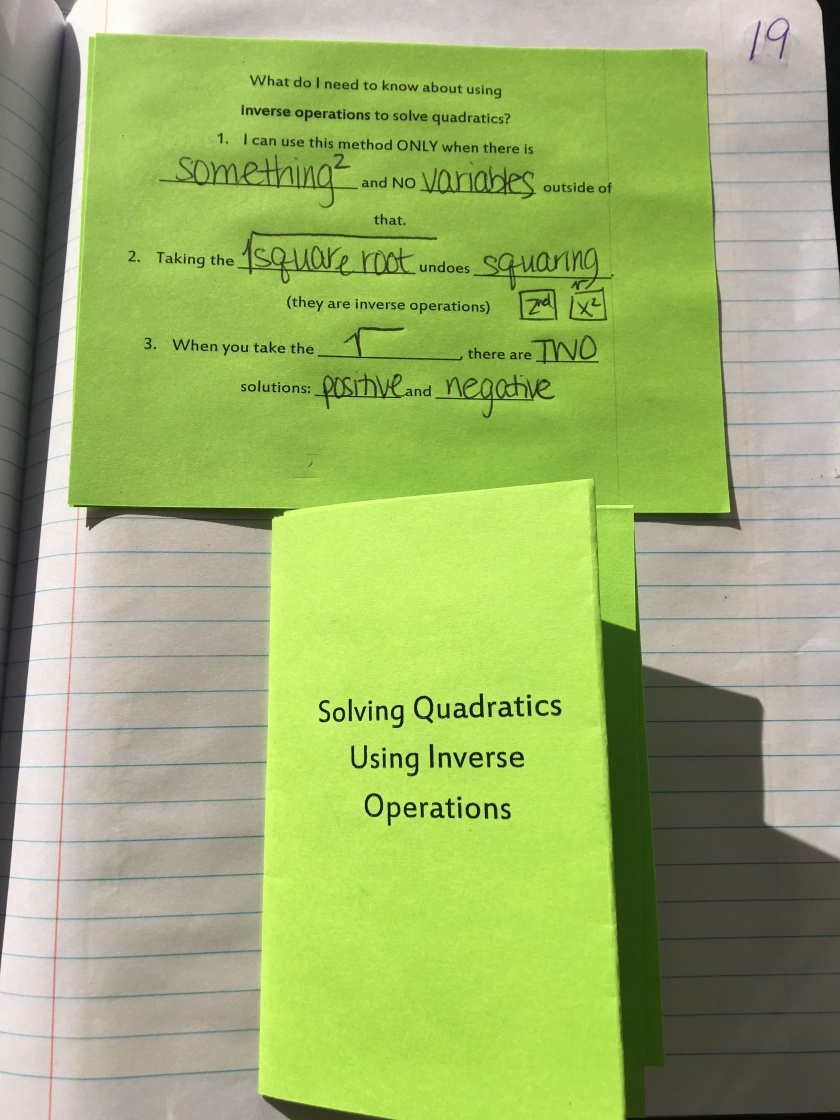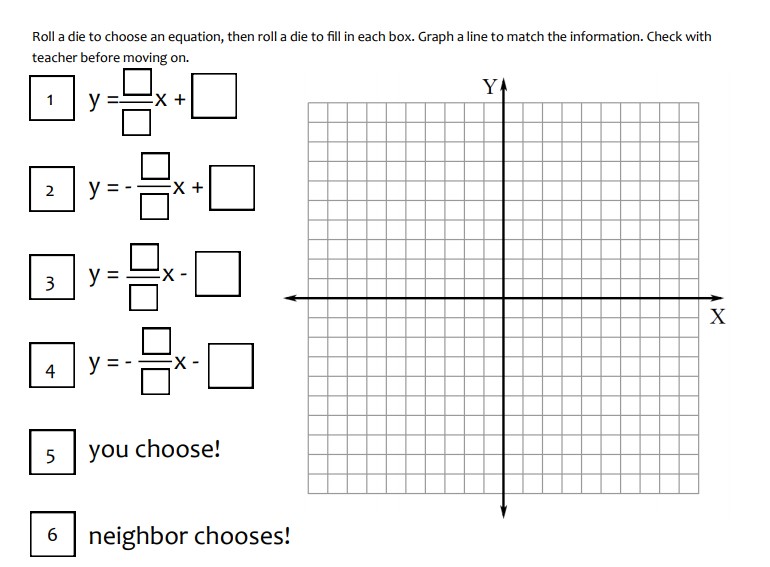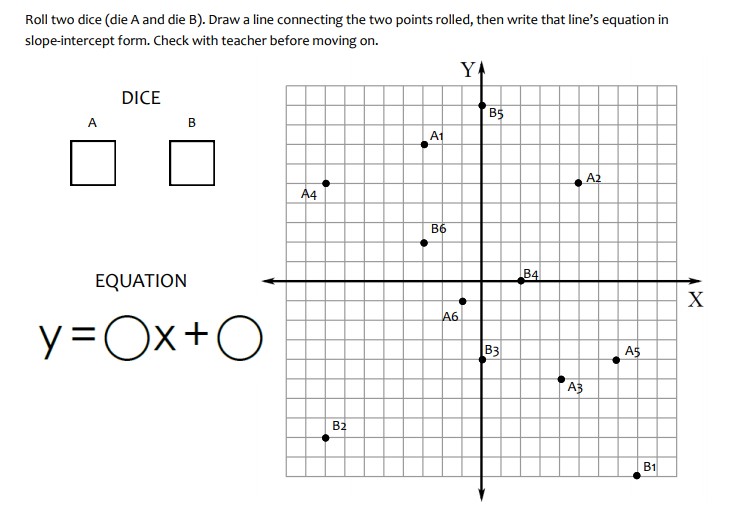This year I’ve committed to posting each unit of both my Algebra 1 and Algebra 2 INBs.
My district is moving to a standards based curriculum, and has identified priority standards for every course. These are the standards we are required to address and assess our students over, so they pretty much form our units.
Other Algebra 2 INB Posts:
Unit 1
Algebra 1 INB Posts:
Unit 1
Unit 2 in Algebra 2 covers N.CN.C.7:
Solve quadratic equations with real coefficients that have complex solutions.
On our index page you can see the skills I broke this down into. Skills 1-4 review methods they (should have) learned in Algebra 1 to solve quadratics with REAL solutions, then we get into the complex solutions idea.
I’ve already decided that I don’t really care about my students recording their assessment scores in their INBs (mostly because I constantly forget to remind them to do this) so starting with our next standard I’m taking those boxes at the bottom off.

In this unit I found myself creating most of my INB pages from scratch (or inspired by those of other teachers), so all of these were created by me!
Skill 1: I can solve quadratic equations using inverse operations.
I wanted to emphasize WHEN you can use this method, because my Algebra 1 students continuously try to use inverse operations always when solving quadratics and force it to work even when it shouldn’t.
The poof booklet underneath the instructions has 6 example problems that we solved together, including one that cannot be solved using inverse operations to reinforce that. I think this emphasis worked really well because I did not have a lot of students trying to use this when they shouldn’t. We’ll see if it works as well with my Algebra 1 students when they get to quadratics at the end of the year!

Skill 2: I can factor a quadratic expression and use factored form to solve solutions or graph.
So this (and inverse operations, and completing the square, and quadratic formula) is supposed to be just a review from Algebra 1. First of all, I have a lot of students who definitely never mastered this in Algebra 1. Second, they were probably taught to factor using one of the many factoring strategies that involves, at some point, guessing and checking a bit. I prefer to teach factoring using the box method, as shown in these notes. My students prefer to have something concrete that doesn’t require them to guess and check. It’s a win-win. As we practice this, I encourage them to use other factoring methods if they learned them well and prefer them, or to skip writing down steps in this method (for example, not listing out every single factor if they can mentally find the right pair immediately). They see a lot of patterns when factoring this way, I find.
I made a dry erase template for them to use when practicing this, and we discussed what parts were the most critical parts to put on paper to show their work. The template is a new iteration formed by a few years of teaching factoring this way and inspired by versions of it from a few other teachers on twitter that I’ve seen! I really like this iteration and don’t think any major changes need to be made at this point.
I gave my students the factor chart you see in the pictures, and originally did not have them put it in their notebooks. When they asked “can we just put this in our notebooks too?” I thought, “duh, why did I not do that originally?”. So next year, I’ll probably print a slightly smaller or somehow more notebook-friendly version of that chart and include it.
We began by just factoring expressions, and then in a poof book moved to solving equations by factoring. I wish I had included some quadratics that cannot be factored here, because my students later got frustrated when they ran into quadratics that I told them they could choose a method to solve, and they wanted to choose factoring…and you couldn’t factor that particular quadratic.
The graph sketching was mostly to remind them that the solutions to the quadratics were the x-intercept of the graph, but I realize now that since this isn’t really the focus of this particular standard, I could have left that whole bit out and moved it to when we talk about polynomials later this year. The poof book itself was good, but it just isn’t necessary in this standard and we could have had more practice time! (which we were short on at the end of this quarter)
Skill 3: I can solve quadratics by completing the square.
This is also supposed to be covered in Algebra 1, but it is the skill that most often gets cut at the end of the year due to time. If they can solve quadratics other ways, and you need to fit in that last unit…completing the square goes. So this was new to most of them.
We started by going back to algebra tiles, because I think this really reinforces two things about completing the square: first, the SQUARE that we are actually completing and second, the splitting the x term in half to form said square. We didn’t actually solve these all the way through, just got them to a point where they looked like inverse operations problems to see the setup. We did a few other examples as a class that they didn’t write down and talked about patterns like the splitting the x term and the fact that you always end up adding positive ones tiles.
I made another template to help us complete the square using algebra, but this one is at a not-so-final iteration stage. My students ended up struggling most with two things. 1. factoring out A – they always forgot to actually factor it OUT of the B term. I would like to somehow emphasize this more by giving them room to show the division on the template or something. 2. multiplying what they added by A before adding it back on to the other side. I put this in small print, so maybe just making it bigger would help. Otherwise, this is the best completing the square has gone for my students in my teaching history. I’m looking forward to making some small changes here and seeing how my Algebra 1 students get on with it later this year.
Skill 4: I can use the Quadratic Formula to find solutions to quadratics.
I am realizing as I type this post that I was really inconsistent with the wording of all these skills…I like this wording better than “solve quadratics using…” so NOTE TO SELF to change all of those to be the same for next year.
I made a dry erase template for this as well, but after realizing that I would pretty much want my students to write all of it on paper to show me their work, I didn’t think there was much point to using them. So we used it as a structure to take notes on, but then didn’t use the templates when practicing. I would like to make an actual box to write about what the discriminant means next time instead of just writing it in the corner, but the students did really well with this. None of them struggled with finding B squared with a negative B value, either, so our note about using parentheses must have helped!
I wish I would have made sure there was an example here with a discriminant of 0. A negative discriminant might have been nice to see as well, although we address those after we learn about complex numbers, just to put in our notes “to be continued in a few days” or something, to get them curious about the square root of a negative number. However, some of them ran into this when they did their practice, because they calculated their discriminants incorrectly and then were trying to take square roots of negative numbers on their calculators.
Skill 5: I can do math with complex numbers and find complex solutions to quadratics.
We introduced this skill by sharing the experiences students had during the last practice when they got a negative discriminant, and then watched this video to introduce imaginary numbers.
We then did some basic math with i to see how its powers form a cycle. Students thought this was pretty wild, that it went from imaginary to real and back again! We used the square roots on the right side of the table to talk about what to actually do with i for our purposes of solving quadratics. There should have also been a lesson in here about simplifying radicals, but we ran out of time, so we left the radicals as is unless it came out to a whole number. I’m hoping we can get to that skill when we address solutions to polynomials 2nd semester – there’s a lot more time scheduled in for that standard than this one!
Then, we just did some examples. Most of them have no real solutions, but a few of them had real solutions just to show students that they need to be able to identify when to use i.
I wish that we had not solved all of these using the Quadratic Formula, because when my students were trying to solve using different methods and came upon the square root of a negative number, they somehow thought it was different than this! I could have used the same examples and just solved one by completing the square instead.
Skill 6: I can select an efficient and appropriate solution method for any quadratic.
Students were pretty easily able to fill in which method went where at the bottom of this flow chart. Again, we were running out of time in the quarter (my students this year really did not act like the solution methods to quadratics were review, so we needed to spend a lot of time on them) and if we had more time, I would have done a card sort and discussion with students sorting various quadratics by the method they would use to solve them WITHOUT actually solving them. It also would have been cool to have students race to solve the same quadratic using different methods and discuss that.
My students were mostly able to settle on one or two methods they felt most comfortable with, and realize that they needed to be able to feel comfortable with either the Quadratic Formula or completing the square to be able to solve ANY quadratic, but they definitely were not choosing the most efficient methods each time. However, this little discussion did help them to know when certain methods wouldn’t work and give them a bit of insight into how to save themselves time.

You can find all the resources shown in this post HERE, most of them in both PDF and Publisher (or Word) format.

















